Lizards are found in many deserts of the world. They can be small, measuring just a couple of inches, or as long as 70 inches.
While most lizards of the desert are harmless, others can be quite aggressive, especially when threatened.
Table of Contents
Desert Lizard Adaptations
Unique adaptations allow desert lizards to live in this place where temperatures are very high during the day and low at night.
Growing spines and horns
A good number of lizards are covered in spines. This makes them difficult to swallow and many predators tend to move away without bothering.
Spines on lizards can be differently colored to the rest of the body. When they are red or white, they can act as warning signals to potential predators as they stand out.
Changing colors
Chameleons are among the lizards of the desert that can change colors.
This is an important adaptation that allows these lizards to live safely in a habitat where hiding spots aren’t easy to find.
Camouflaging colors are also common for lizards of various species. A mottled appearance allows them to hide in plain sight from predators such as snakes, scorpions, or other lizards.
Eating ants and termites
While food is scarce in deserts, there are plenty of ants and termites for lizards to feed on.
Some lizards, such as The Regal Horned Lizard can even eat thousands of ants during a day. They can sit next to an ant mound to wait for ants to come out as they are hungry all the time.
Other lizards dive into the sand for various bugs and termites they share their desert climate with.
Burrowing and sand diving
Most species that want to get out of the sun in the desert tend to live in burrows.
Several species know how to dive in loose sand which means they can make a quick escape as soon as they notice a potential threat.
Lizards That Live in the Desert
Tens of lizards live in the desert, sometimes even sharing the same scarce food sources as follows.
1. Desert Spiny Lizard
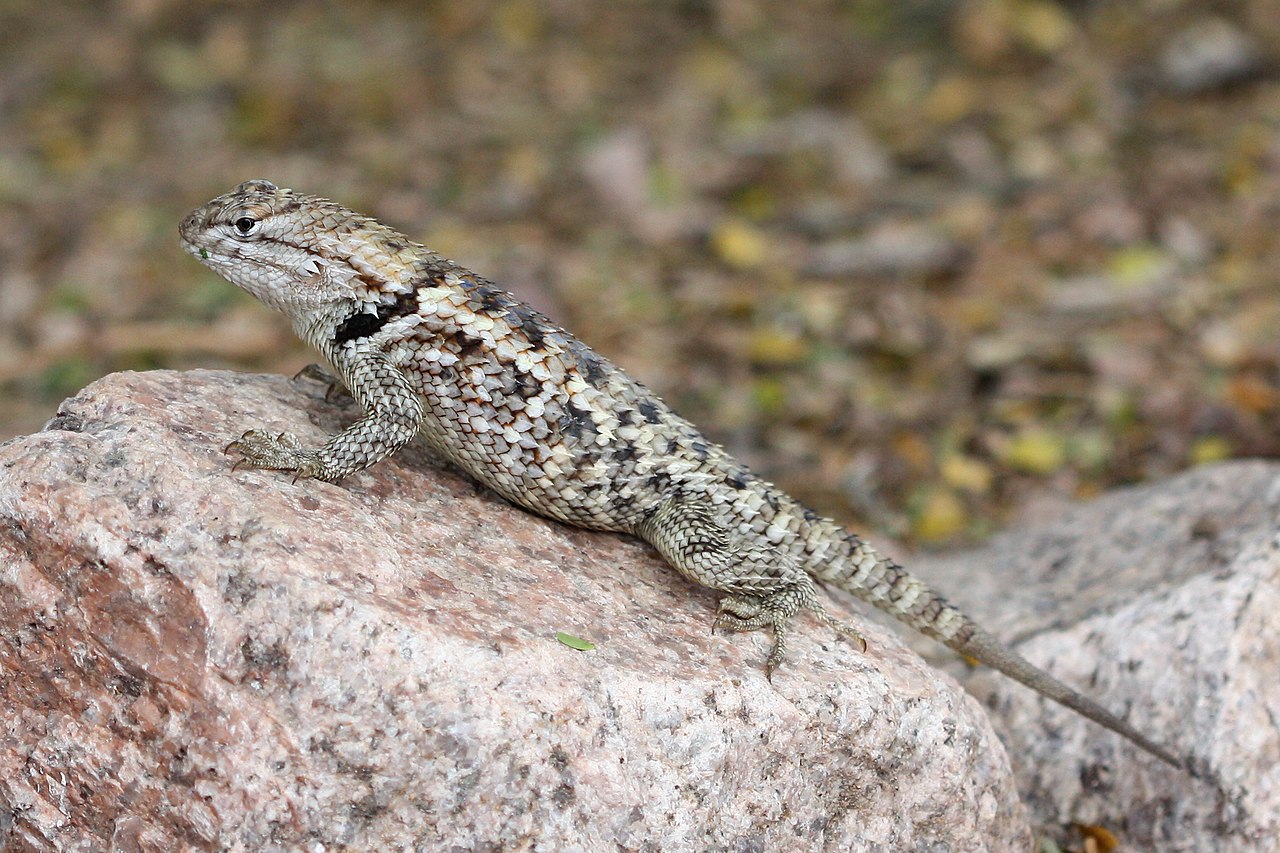
A species that lives in The Chihuahuan and The Sonoran Deserts, this lizard (Sceloporus magister) is named after the multiple rows of spines on its back.
It features white, gray, and black patterns but males can be distinguished by their blue underbellies.
Coloring in itself isn’t linear in the species as these lizards change colors with the seasons.
This is an adaptation that allows them to either cool off or get warmer.
In the cooler months, Desert Spiny Lizards become darker. This allows them to take in more heat from the soon as opposed to their bright summer variant which reflects more heat.
Reaching a size of up to 5.6 inches, these lizards can be active throughout the year, especially when ants and bugs are also active.
2. Desert Horned Lizard

A species of The Sonoran Desert, this type of lizard (Phrynosoma platyrhinos) is often believed to have horns.
Long scales found on its head make the species look horned. Further smaller scales are specific to this species on its upper back.
Apart from the scales which keep some predators away, Desert Horned Lizards are also adapted to the desert climate with their flat tails.
Taking the appearance of their rocky terrains in the desert, these lizards are ambush predators, not moving for hours waiting for prey to come around.
Desert Horned Lizards can also use the position of their tail to signal a higher social hierarchy compared to other lizards.
3. Desert Collared Lizard

Deserts of the Southwestern US are home to The Desert Collard Lizard (Crotaphytus bicinctores).
Mostly seen in desert scrub, this species shows black collars around its neck, brown-orange legs, and a patterned head.
Its sizes are highly variable. Desert Collard Lizards can measure a mere 2.4 inches as adults but they can also grow to more than 4 inches.
While they don’t bite, these lizards are powerful and have a varied diet which even includes small snakes.
Other small lizards are a more common food choice but this species can eat almost anything from plants to bugs and vertebrates.
4. Desert Night Lizard

This species of spotted lizard (Xantusia vigilis) is endemic to The Colorado and Mojave Deserts.
It’s also one of the smaller species here as a typical adult can measure less than 2 inches and rarely more than 2.5 inches.
Desert Night Lizards spend most of their days hiding under rocks or vegetation.
They can be seen in shaded places and burrows. The shade of a yucca tree can be a good place for it to hide.
Lizards of this species don’t have a different diet compared to other lizards in these deserts.
They eat small insects such as ants and the occasional termites in the area.
Often spotted in an area where they live in groups, Desert Night Lizards spend most of their in the same areas.
5. Colorado Desert Fringe-toed Lizard

A species of The Colorado Desert, this type of lizard (Uma notata) has a unique appearance and color combinations.
Bright gray base nuances are specific to the species which additionally shows black dorsal patterns.
This is also a species that shows orange spots between its dorsal patterns as well as additional orange stripes along its body.
A diurnal species, the lizard has bright underbelly coloring. Cream to white, the underbelly isn’t patterned as its dorsum.
6. Wedge-snouted Desert Lizard

A species of The Namib Desert, The Wedge-snouted Desert Lizard (Meroles cuneirostris) mostly comes in orange-brown nuances.
Its tail can also be mostly orange in its early days.
The species can change colors with the seasons.
This is why it may only be orange during the warmest periods of the year and even turn dark brown in the cooler months.
Its brown variant shows dark brown lateral bands and gray-brown mid-dorsal sections.
This brown variant also changes the color of its underbelly from orange-brown to pure white.
7. Yuman Desert Fringe-Toed Lizard

This patterned lizard is endemic to The Yuma Desert.
While reports of its presence in Southern Arizona exist, the lizards are prevalent in the Northern state of Sonoma in Mexico.
A bright species with earthy or sand nuances, The Yuman Desert Fring-Toed Lizard (Uma rufopunctata) has a patterned dorsum.
It features black patterns across the dorsum with orange spots between them.
Unlike many patterned lizards, this is also a species with a pattern-free head, as only the areas of its neck show the same patterns seen on its back.
A diurnal species feeding on insects, this lizard also stands out with the orange line seen above its eyes.
8. Blanford’s Short-Nosed Desert Lizard
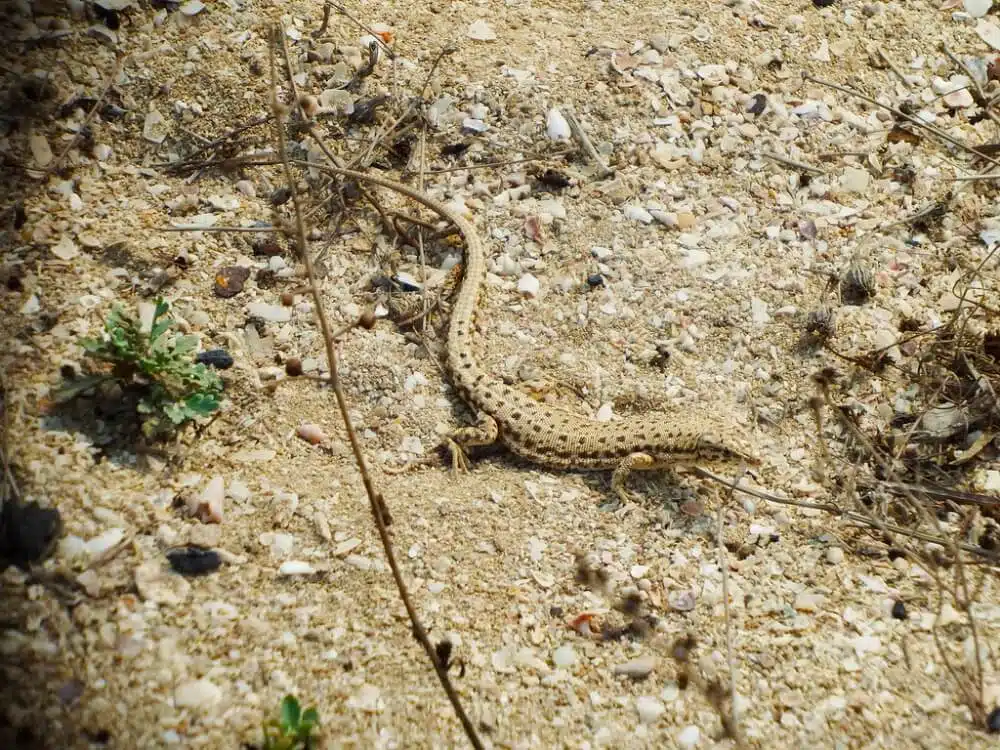
A species of Saudi Arabia, Blanford’s Short-Nosed Desert Lizard (Mesalina brevirostris) lives in desert scrub.
It comes in different neutral colors such as gray, gray-green, and beige.
A pattern of dark and bright spots is mostly specific to its dorsum.
This is a species with similar patterns across its dorsum, tail, legs, and head.
White and dark gray spots are seen on the species which makes it look similar to the rocky habitats it inhabits.
Also diurnal, the species feeds on plants and insects but it may prefer to remain hidden in a shaded place during the hottest periods of the day.
9. Spotted Desert Lizard

Native to The Namib Desert, The Spotted Desert Lizard (Meroles suborbitalis) is a species that has a bright appearance.
Diurnal lizards of this type have small black spots on the dorsum and larger black spots on the tail.
A gray or gray-to-yellow color is specific to its back while the tail is mostly yellow and white.
Its legs have a bright yellow color while its head only has yellow and white coloring around its mouth as the top of its head is yellow-gray.
White underside coloring completes the look of these lizards.
As juveniles, the lizards are much brighter. They’re almost completely yellow or tan with visible but smaller black spots.
10. Smith’s Desert Lizard
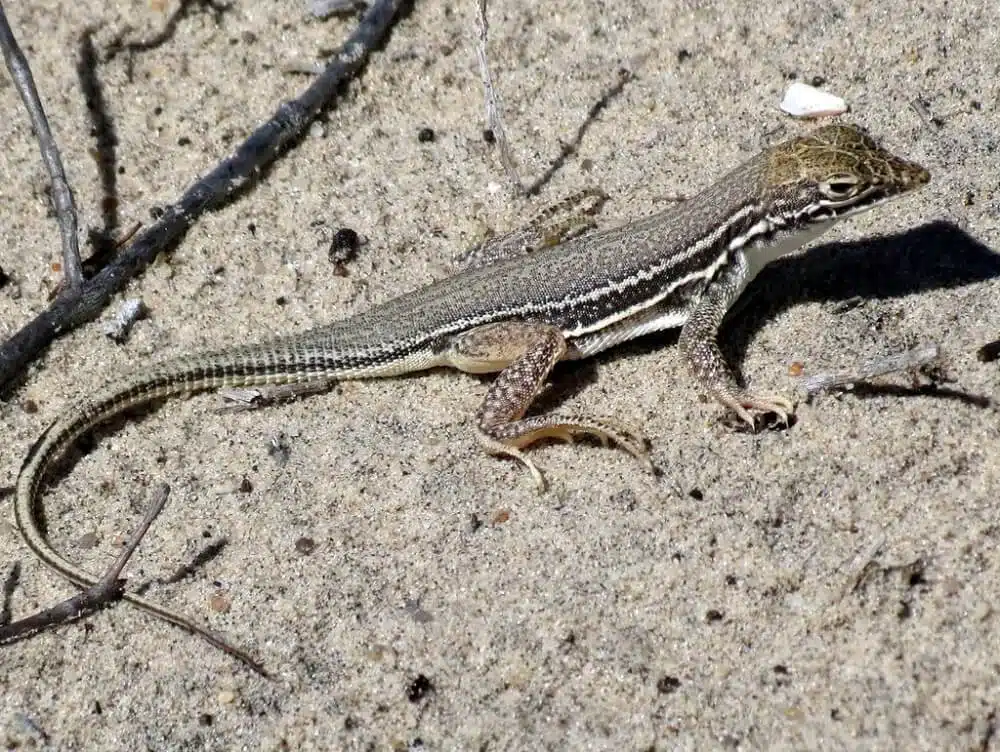
Native to The Namib Desert, Smith’s Desert Lizard (Meroles ctenodactylus) is a species that comes in different colors.
The lizard can be mostly gray or mostly red-orange, typically with stripes.
Its gray morph comes with black and white stripes bordering each other on the sides.
Gray nuances can dominate its dorsum while yellow-golden nuances can be spotted on its head during the summer.
The more colorful morph of the species is orange-red. This variant also comes with white and black stripes on the sides and white undersides.
As with the gray morph, its orange-red morph also shows dark patterns both across the dorsum and on the legs.
11. Desert Plated Lizard

Reaching a size of up to 4 inches, Desert Pleated Lizards (Gerrhosaurus skoogi) are native to The Namib Desert.
It’s here that the lizard, together with many other species, feeds on the local Namib plant.
Desert Pleated Lizars still eat both plants and insects.
This is a cream-colored lizard with red-brown alternating marks.
As lizards that live long lives, Desert Pleated Lizards can survive up to 10 years.
They live in small groups in a small habitat, typically reducing their risk of predation by numbers.
These types of lizards also tend to stick closer together during the cooler days when food sources are rare and when they might feed on seeds.
12. Desert Monitor

Desert Monitors (Varanus griseus) are some of the largest lizards in the desert.
This is a species that can reach lengths of up to 78 inches, including its tail.
Color variability is also high in the species, but tends to be dominated by black horizontal bands.
Desert Monitors are further known for their red, brown, yellow, and gray nuances, contrasting the black bands that run from head to tail.
The species is terrestrial and diurnal, mostly inhabiting East Africa, North Africa, The Middle East, and Asia.
It lives in desert dunes, preferably in rock outcroppings where it can retreat.
While large, The Desert Monitor is a species that hibernates. The duration of its hibernation depends on the season but may last a few months.
13. Desert Skink

Desert Skinks (Liopholis inornata) are native to Australia and live in arid sandy desert habitats.
They share some of the red-brown colors of their habitats and spend most of their time underground in burrows.
Relying on camouflage to escape predators, Desert Skinks don’t rely on camouflage for predation.
They must eat termites they find in the ground or in mounds. In rare cases, they can also eat plants such as various grasses.
The predation method of the species is still based on waiting around as Desert Skinks don’t dive into termite mounts.
Instead, they wait for termites to exit to attack.
14. Common Desert Ctenotus
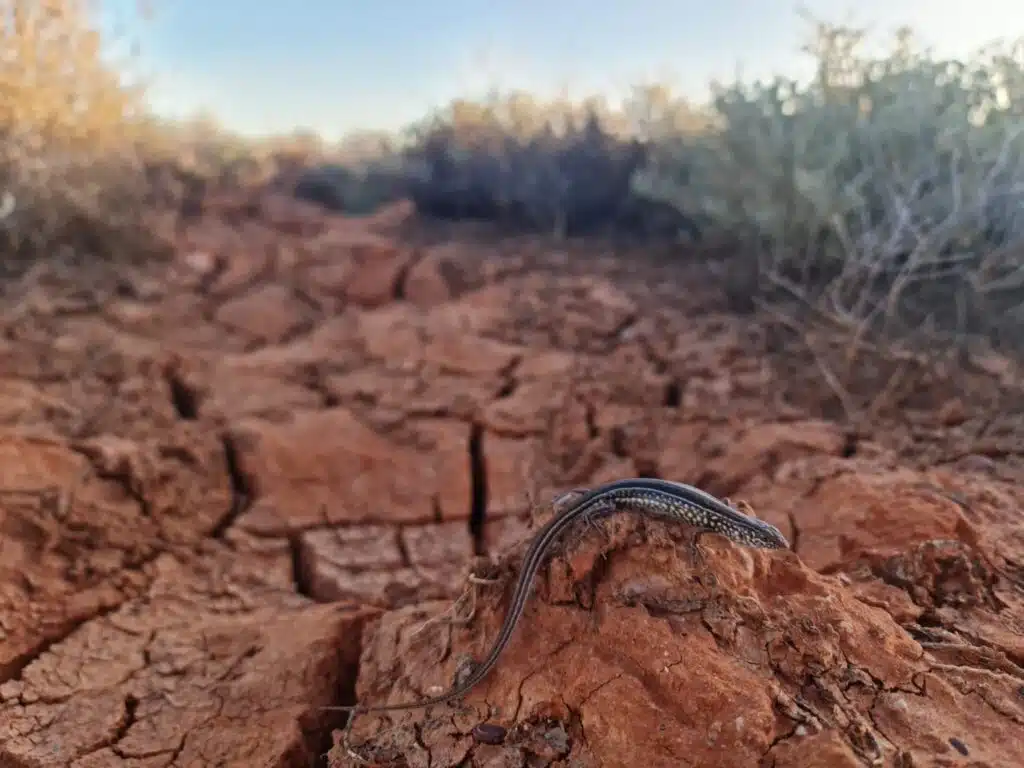
Also native to Australia, Common Desert Ctenotuses (Ctenotus leonhardii) have a striped and spotted appearance.
Long black stripes running from head to tail are specific to these lizards which additionally show bright spots between these stripes.
Common Desert Ctenotusesa aren’t heavily focused on one species for feeding, as Desert Skinks.
Instead, these lizards have a varied diet which includes spiders and cockroaches.
While a diurnal species that still comes out at noon, Common Desert Ctenotuses can enter hibernation-like periods.
These are long periods of inactivity when the weather gets either too hot or too cold.
This lizard likes dry weather and may even enter a period of reduced activity when it rains.
15. Desert Wall Gecko
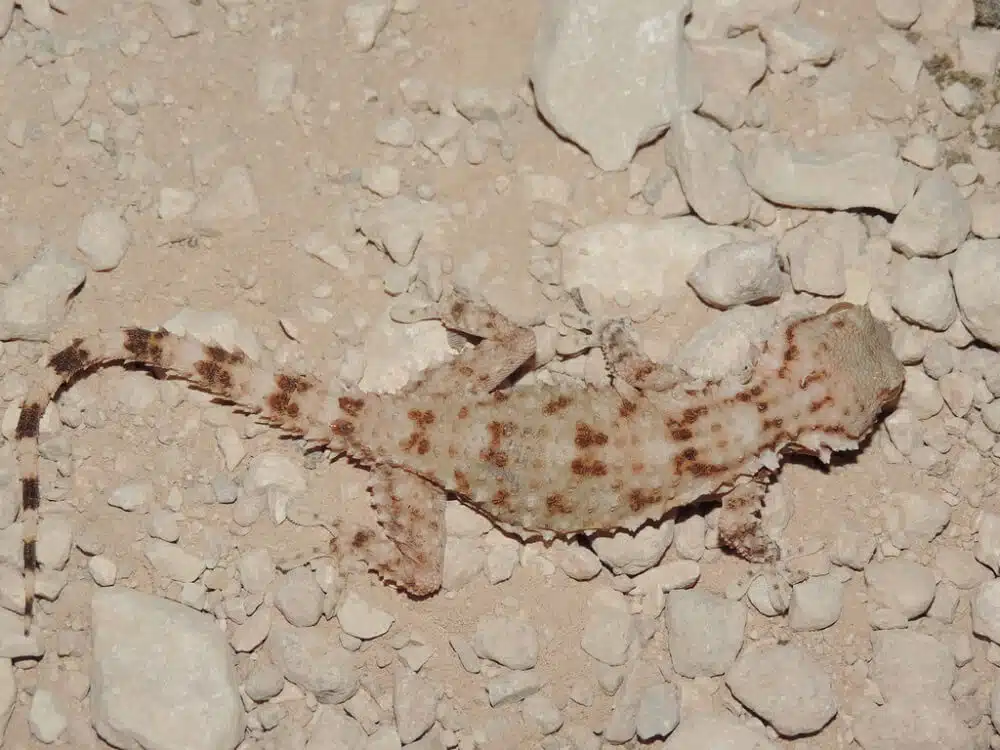
A species with a mottled appearance, The Desert Wall Gecko (Tarentola deserti) is a species found in North Africa.
These lizards are found in Algeria, Tunisia, and Morocco where they can have different colors.
A black-banded tail morph with gray-brown dorsum coloring is specific to the species. These lizards have black patterns that cover their dorsum and expand onto the top of the head.
From rocky areas to areas with short vegetation, this is a lizard that lives in a varied habitat, including farmland.
Desert Wall Geckos are also a common sight next to inhabited areas.
16. Namib Desert Gecko
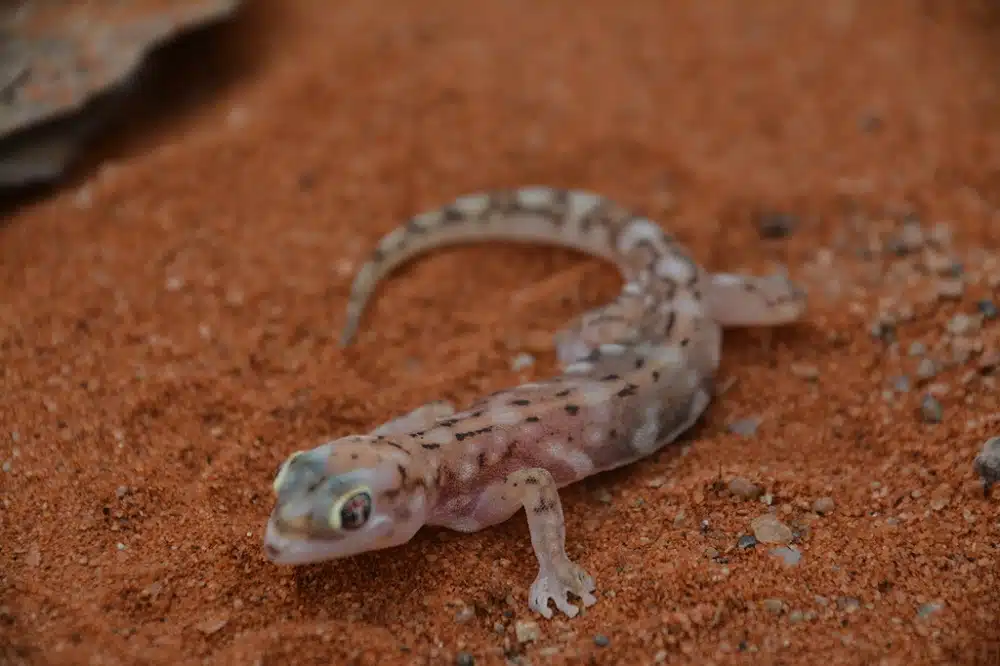
Native to The Namib Desert, this gecko (Pachydactylus vanzyli) is one of the smallest lizards in the desert.
Even adult lizards may only reach a maximum length of 2 inches.
Mostly nocturnal, The Namib Desert Gecko has a bright gray base color, white and black spots.
Unlike other lizards, it also has white circles around its large eyes.
It also has translucent skin on the extremities of its legs.
The species spends much of its time in the ground and it comes out for food such as termites and other insects.
17. Thorny Devil

Native to Australia, Thorny Devils (Moloch horridus) are among the lizards of the desert with spines.
The entire body of these lizards is covered in spines and may even make it look as if their heads have horns.
These are fake horns or spines, like those on its back.
Lizards of the family rely on these spines to keep predators away and even lower their heads to show their spines at the back of the head better.
From brown to gray, the lizard comes in multiple colors and predators know to stay away as they can’t be easily eaten.
The result is one of the longest-living lizards of the desert as Thorny Devils can live up to 20 years.
18. Gila Monster

Gila Monsters (Heloderma suspectum) are some of the species of the desert subject to myths.
This is a venomous species, after all. Its sharp bite is painful while its venom is potentially beneficial.
The venom of the species is being researched for its potential benefits in the mentalism of sugar and for diabetics.
Found in The Sonoran Desert, Gila Monsters rarely get to bite humans.
The fact that it lives in a remote area contributes to this statistic, together with the fact that the species is quite slow.
Its long and powerful jaws make this a fierce predator in the desert. They can eat small mammals, including squirrels and other lizards.
19. Sandfish Skink

Sandfish Skinks (Scincus scincus) are named after their capacity to dive into sand dunes and their fish-like shape.
This is a species of The Sahara Desert where the temperature difference between the day and the night is considerable.
Sandfish Skinks are perfectly adapted to living on sand dunes where they can detect movements.
The small movements of bugs and insects give away their location.
A caramel species, the skink also has distinct wide black marks across its body and more pronounced yellow nuances closer to the tail.
20. Indian Spiny-Tailed Lizard
The Indian Spiny-Tailed Lizard (Saara hardwickii) is a large species from India and Pakistan.
This is one of the many hibernating species of lizards in the world. It begins in activity in the spring when it looks for a breeding partner.
One distinct physical trait of the species includes a spiny tail that resembles the tail tip of rattlesnakes.
A large species, The Indian Spiny-Tailed Lizard grows to 16 inches.
This large size also means the species is known for its large eggs, which are some of the largest among all desert lizards.
21. Desert Rainbow-Skink

Some desert lizards change their colors or adapt their colors during the breeding season.
This (Carlia triacantha) is a physical adaptation to draw in more possible breeding partners.
Desert Rainbow-Skinks are among the Australian lizards that change colors. They get a blue head and a red body, in the case of the males, in the breeding season.
Growing to a size of just over 2 inches, this is a species that lays 1-2 eggs per breeding season.
22. Rusty Desert Monitor

Reaching a size of up to 19 inches, Rusty Desert Monitors (Varanus eremius) are some of the larger species of lizards in the desert.
An Australian native, this is a lizard with a rust-red color specific to its dorsum while its underside is mostly white.
These lizards additionally feature black stripes along the tail.
Rusty Desert Monitors mostly feed on other lizards, mainly those that are smaller. They only rarely eat insects.
23. Namaqua Chameleon

The Namib Desert is home to The Namaqua Chameleon (Chamaeleo namaquensis). This is a species with a spiny back which may act as a first barrier against its predators.
Females of the species grow larger than males, often reaching a size of up to 9 inches.
This species can change colors, depending on its mood. While it can be gray or brown, The Namaqua Chameleon can also be red and rust-red.
Short dark bands are specific to its dorsum.
24. Namib Sand-Diver

A species with an elongated snout, this (Meroles anchietae) is a type of lizard adapted to digging into loose sand.
Spotted on the dunes of The Namib Desert, this species is further known for its yellow color with black dorsal patterns and white underside.
A small type of lizard, the terrestrial Namib Sand-Diver grows to 2 inches.
It survives the adverse condition of its Southwestern African desert by eating insects.
25. Chihuahua Desert Horned Lizard

Mostly found in Mexico, this lizard (Phrynosoma orbiculare) is known for its spiny appearance.
Short spines on the dorsum come in all colors on the lizard. There are even 2 rows of white spines on the sides of its body.
Black and red spines dominate the central area of its dorsum.
The species also shows dark red spines at the back of its head, which it can use to push against the hand when handled.
26. Regal Horned Lizard

A species of the Southwestern US desert, The Regal Horned Lizard (Phrynosoma solare) has fake horns or spines across its head and dorsum.
This is a species that comes in yellow and brown colors or bray variants.
Regal Horned Lizards may be slow, but they eat a lot. They prefer ants to other types of insects.
This is a lizard that relies on its spines to keep predators away together with other less-obvious deterring techniques.
A rare capacity to shoot blood out of its eyes helps the lizard play dead in front of a threat.